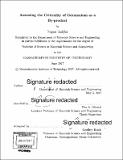Assessing the criticality of germanium as a by-product
Author(s)
Tadjfar, Nagisa
DownloadFull printable version (3.669Mb)
Other Contributors
Massachusetts Institute of Technology. Department of Materials Science and Engineering.
Advisor
Elsa A. Olivetti.
Terms of use
Metadata
Show full item recordAbstract
Although germanium production is currently nowhere near its supply potential, many sources cite germanium, a by-product material produced primarily from zinc and coal, as a critical metal. Current methods for assessing criticality include frameworks that rely on geopolitical risk metrics, geological reserves, substitutability, and processing limitations during extraction among others but there is a gap in understanding the complex supply and demand dynamics that are involved in the market for by-products. This thesis addressed this gap by assessing the supply risk of germanium using an econometric framework to generate estimates of price elasticities. Annual world production and price data of years 1967 - 2014 for germanium was used to construct supply and demand models in order to obtain estimates for the price elasticities of supply and demand. Ordinary least squares (OLS) regression was used on an autoregressive distributed lag (ARDL) model for both supply and demand. The supply model was constructed with price, zinc production, and 5-year interest rate as shifters along with lag terms for germanium production, germanium price, 5-year interest rate, and zinc production. The adjusted R2 was 0.761 and the long term supply price elasticity was found to be 0.05 with an upper bound of 0.7 and a lower bound of -0.6 indicating that germanium supply is price inelastic. In a similar fashion, a demand model was constructed with two structural breaks accounting for fundamental changes in the market structure in 1991 and 2003, along with lag terms for germanium production, germanium price and antimony price. The adjusted R2 value for the demand model was 0.683 and the price elasticity was 0.05 with an upper bound of 1 and a lower bound of -1 indicating that demand, too, is price inelastic. This creates an added risk for supply shortages, adding to the criticality of germanium. However, the stabilizing behavior of its carriers, coal and zinc, reduce the likelihood of an actual shortage. This type of analysis improves upon existing methods and can lead to more accurate quantified estimates for long-term criticality.
Description
Thesis: S.B., Massachusetts Institute of Technology, Department of Materials Science and Engineering, 2017. Cataloged from PDF version of thesis. Includes bibliographical references (pages 37-38).
Date issued
2017Department
Massachusetts Institute of Technology. Department of Materials Science and EngineeringPublisher
Massachusetts Institute of Technology
Keywords
Materials Science and Engineering.